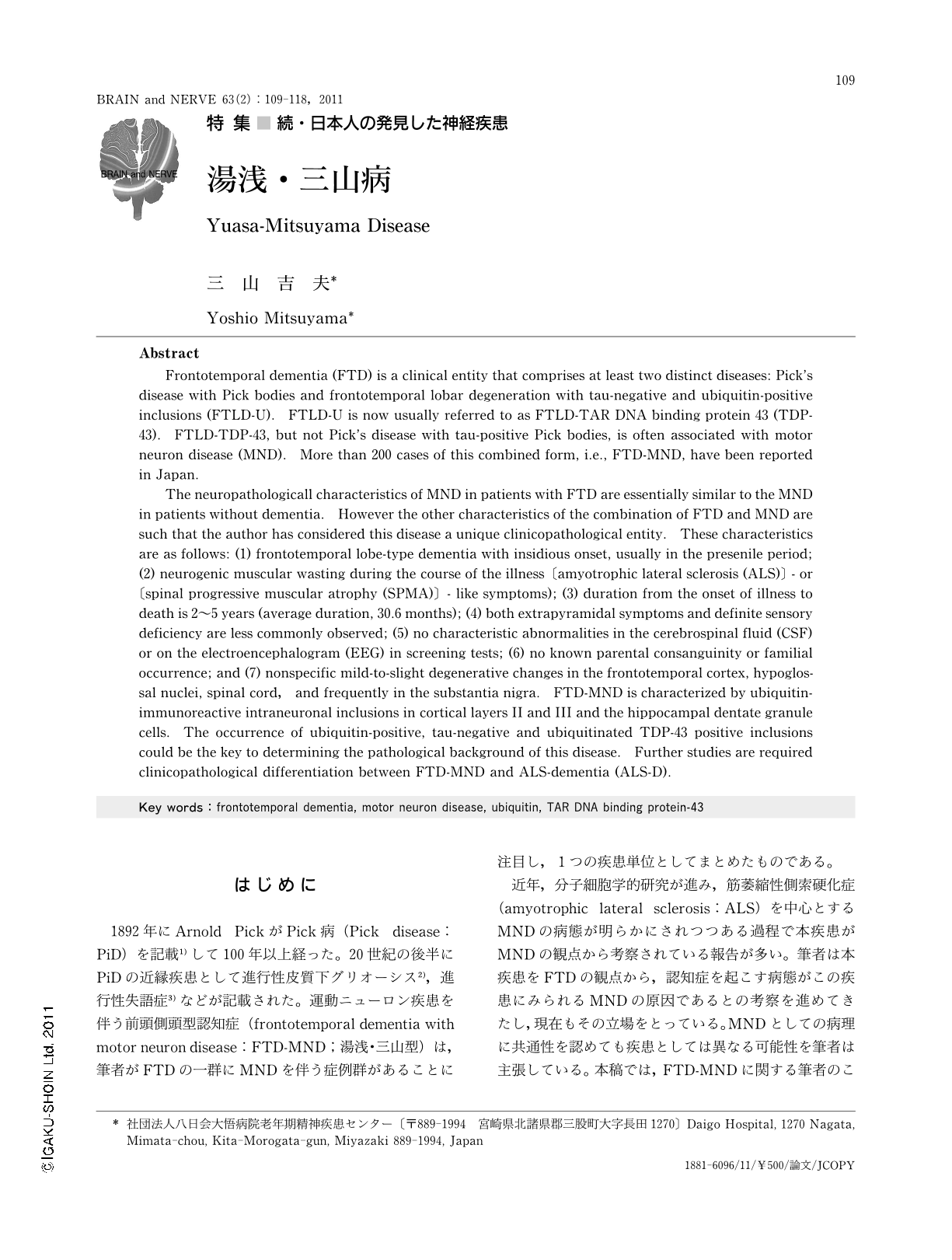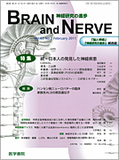Japanese
English
- 有料閲覧
- Abstract 文献概要
- 1ページ目 Look Inside
- 参考文献 Reference
はじめに
1892年にArnold PickがPick病(Pick disease:PiD)を記載1)して100年以上経った。20世紀の後半にPiDの近縁疾患として進行性皮質下グリオーシス2),進行性失語症3)などが記載された。運動ニューロン疾患を伴う前頭側頭型認知症(frontotemporal dementia with motor neuron disease:FTD-MND;湯浅・三山型)は,筆者がFTDの一群にMNDを伴う症例群があることに注目し,1つの疾患単位としてまとめたものである。
近年,分子細胞学的研究が進み,筋萎縮性側索硬化症(amyotrophic lateral sclerosis:ALS)を中心とするMNDの病態が明らかにされつつある過程で本疾患がMNDの観点から考察されている報告が多い。筆者は本疾患をFTDの観点から,認知症を起こす病態がこの疾患にみられるMNDの原因であるとの考察を進めてきたし,現在もその立場をとっている。MNDとしての病理に共通性を認めても疾患としては異なる可能性を筆者は主張している。本稿では,FTD-MNDに関する筆者のこれまでの考察を振り返りながら,疾患単位としての意義を述べる。
Abstract
Frontotemporal dementia (FTD) is a clinical entity that comprises at least two distinct diseases: Pick's disease with Pick bodies and frontotemporal lobar degeneration with tau-negative and ubiquitin-positive inclusions (FTLD-U). FTLD-U is now usually referred to as FTLD-TAR DNA binding protein 43 (TDP-43). FTLD-TDP-43, but not Pick's disease with tau-positive Pick bodies, is often associated with motor neuron disease (MND). More than 200 cases of this combined form, i.e., FTD-MND, have been reported in Japan.
The neuropathologicall characteristics of MND in patients with FTD are essentially similar to the MND in patients without dementia. However the other characteristics of the combination of FTD and MND are such that the author has considered this disease a unique clinicopathological entity. These characteristics are as follows: (1) frontotemporal lobe-type dementia with insidious onset,usually in the presenile period; (2) neurogenic muscular wasting during the course of the illness〔amyotrophic lateral sclerosis (ALS)〕 - or〔spinal progressive muscular atrophy (SPMA)〕- like symptoms); (3) duration from the onset of illness to death is 2~5 years (average duration,30.6 months); (4) both extrapyramidal symptoms and definite sensory deficiency are less commonly observed; (5) no characteristic abnormalities in the cerebrospinal fluid (CSF) or on the electroencephalogram (EEG) in screening tests; (6) no known parental consanguinity or familial occurrence; and (7) nonspecific mild-to-slight degenerative changes in the frontotemporal cortex,hypoglossal nuclei,spinal cord, and frequently in the substantia nigra. FTD-MND is characterized by ubiquitin-immunoreactive intraneuronal inclusions in cortical layers II and III and the hippocampal dentate granule cells. The occurrence of ubiquitin-positive,tau-negative and ubiquitinated TDP-43 positive inclusions could be the key to determining the pathological background of this disease. Further studies are required clinicopathological differentiation between FTD-MND and ALS-dementia (ALS-D).

Copyright © 2011, Igaku-Shoin Ltd. All rights reserved.


